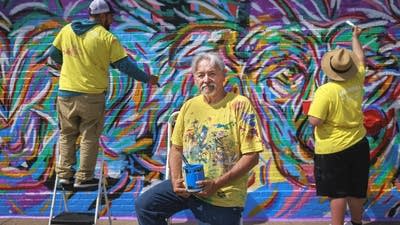Minn. artist has deep roots in Chicano art movement

Go Deeper.
Create an account or log in to save stories.
Like this?
Thanks for liking this story! We have added it to a list of your favorite stories.
Sitting in the sun room of his home in Oak Park Heights, his dog Ruby napping nearby, Jimmy Longoria recalled the moment he had a chance encounter with famed Mexican artist Rufino Tamayo.
Longoria was 16, and had been invited by a mentor to attend a party in the Hollywood Hills, a party being hosted by a Mexican actress. Tamayo was a guest.
Longoria went out to where Tamayo was painting in the backyard. He spoke to the maestro in Spanish.
“He says, ‘By the way, when you become an artist…’
Turn Up Your Support
MPR News helps you turn down the noise and build shared understanding. Turn up your support for this public resource and keep trusted journalism accessible to all.
I said, ‘I have no interest in being an artist. I'm going to be a governor.’
He says, ‘Well, if you get around to it, you got to understand that you need to have a Mrs. Tamayo [his wife] because Mrs. Tamayo takes care of everything I do, and makes it possible for me to just paint.’”

Longoria didn’t know it at the time, but Tamayo’s words would be prophetic. Four years later, Longoria made a decision that would change his life. And his art career began when, while attending Pitzer College in Claremont, California, he changed his course of studies to art.
His day job brought him to Minnesota in 1988. Where, like so many others, he thought he’d stay just a few years.
“My first year, I was walking my dog in the middle of the night in the middle of a blizzard, in my slippers, my boxers and my parka. And I went, ‘Ah, I'm gonna stay’ and then proceeded to stay,” he said.
Longoria calls himself The Chicano artist of Minnesota.
He chose to be a Chicano artist in 1974, he said. Longoria chose to identify as a Chicano artist based on his experiences in Texas where he was born.
“All over Texas the signs go up: no dogs, no negros, no Mexicans. My family cultural history, the oral history was, you're not a Mexican, you're not from Mexico, you're from here from this area, you're Tejano. But as far as the sheriff was concerned, as far as the people who controlled all the social and political structures in South Texas, I'm a Mexican, there is no difference,” Longoria said.
The definition of Chicano varies depending who you ask. And Chicano art is no exception.
Chicano art grew from the Movimiento – the 1960s Chicano Movement which fought for social justice.
Longoria has his own definition of Chicano.
“It's an exploratory culture. In other words, instead of looking back for justification and foundations, I'm not looking for the base of a pyramid. I'm looking at what a pyramid looks like in Minnesota. What's the future of that pyramid? And what is the function of a pyramid? An artist has a different way of looking at things now,” he said.

In June, Chicano art hit the spotlight with the opening of The Cheech Marin Center for Art and Culture in Riverside, California.
And because of that, Longoria said many collectors will be wanting to add Chicano art to their collections.
His art hangs everywhere in his home. And more art is stacked in a room he calls the vault, which sits adjacent to his downstairs studio.
But his artwork can also be found in the office of U.S. Supreme Court Justice Sonia Sotomayor; Cheech Marin’s private collection; and even in the bathrooms of the Bush Foundation offices.
If you look closely at his paintings, none of the canvases have a signature. In fact, none of his original pieces have a signature. A signature only appears on reproductions, Longoria said.
Baseball fans attending Tuesday’s game will have an opportunity to own a T-shirt with a reproduction of Longoria’s artwork.
He was approached in February by the Minnesota Twins who asked for some of his artwork.
“It's funny, because they said ‘we just, (want) anything that has your art,’ I said, ‘That's not the way I work. So I made five different designs,” Longoria said.
Longoria said the Twins chose the “tamer” of the designs for the shirt. And they also insisted on a signature.
The shirts will be given to the first 5,000 fans entering the gate. And are being given away just in time to kickoff Hispanic Heritage Month which begins Sept. 15.
Vicki Adame covers Minnesota’s Latino communities for MPR News via Report for America, a national service program that places journalists into local newsrooms to report on undercovered issues and communities.










